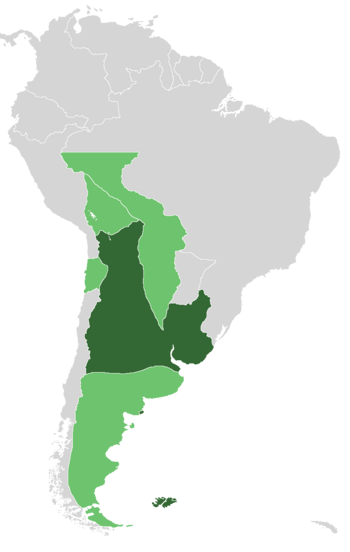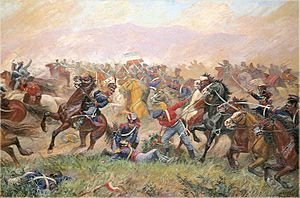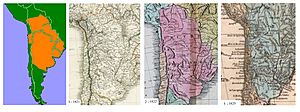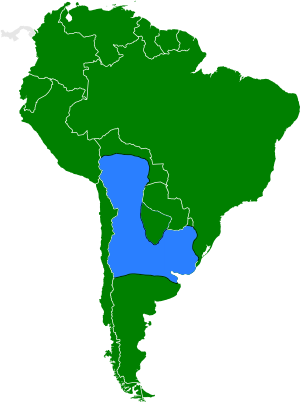United Provinces of the Río de la Plata facts for kids
Quick facts for kids
United Provinces of the Río de la Plata
(United Provinces of South America) Provincias Unidas del Río de la Plata
(Provincias Unidas de Sudamérica) |
|||||||||||||||
|---|---|---|---|---|---|---|---|---|---|---|---|---|---|---|---|
| 1810–1831 | |||||||||||||||
|
|
|||||||||||||||
|
Anthem: National Anthem of Argentina
|
|||||||||||||||
 |
|||||||||||||||
| Capital | Buenos Aires |
||||||||||||||
| Common languages | Spanish | ||||||||||||||
| Religion | Christianity | ||||||||||||||
| Government |
|
||||||||||||||
| Head of State | |||||||||||||||
|
• 1810–1816
|
Ferdinand VII of Spain | ||||||||||||||
|
• 1829–1831
|
Juan Manuel de Rosas | ||||||||||||||
| Historical era | Napoleonic Wars | ||||||||||||||
| 1806–1807 | |||||||||||||||
| 25 May 1810 | |||||||||||||||
| 9 July 1816 | |||||||||||||||
|
• Battle of Cepeda
End of centralized authority |
1 February 1820 | ||||||||||||||
|
• First Presidency
|
8 February 1826 | ||||||||||||||
|
• Treaty of Montevideo
Independence of Uruguay |
28 August 1828 | ||||||||||||||
|
• Pacto Federal
|
4 January 1831 | ||||||||||||||
| Currency |
|
||||||||||||||
|
|||||||||||||||
The United Provinces of the Río de la Plata (Spanish: Provincias Unidas del Río de la Plata) was a country in South America. It was also known as the United Provinces of South America. This name was chosen in 1816 by the Congress of Tucumán.
This region declared its independence in 1816. The Argentine War of Independence (1810–1818) led to its creation. This war started with the May Revolution in 1810. The United Provinces were made up of areas that used to be part of the Spanish Viceroyalty of the Río de la Plata. Its capital city was Buenos Aires.
The name "Provincias del Río de la Plata" means "Provinces of the River Plate". This name was used for the area until a new constitution was made in 1826. Today, the Constitution of Argentina still recognizes Provincias Unidas del Río de la Plata as one of the official names for Argentina.
Contents
Where Were the United Provinces Located?
The United Provinces of South America were surrounded by different lands and peoples. To the south, there were vast, open lands called the Pampas and Patagonia. These areas were home to native groups like the Mapuche and Ranquel peoples.
To the north, the Gran Chaco region was home to the Guaycuru nations. To the northwest, across the Upper Peru, was the Spanish Viceroyalty of Peru. The Andes mountains were to the west, and beyond them lay the Spanish-controlled Captaincy General of Chile. To the northeast was Colonial Brazil, which was part of the Portuguese Empire.
How the Government Changed
The change from being a Spanish Viceroyalty to the United Provinces was a big step. It was a revolutionary process that aimed to replace the Spanish king with an independent republic. A republic is a country where citizens elect their leaders.
New ideas from the Enlightenment in Spain helped inspire these changes. Also, the Peninsular War in Europe left Spain without a clear king. This made people think about who should rule. The idea of separation of powers became important. This means dividing government power into different parts to prevent any one person from having too much control.
The new political situation caused many arguments among the cities. Some people believed that power should go to other Spanish officials. Others thought that power should return to the people. They believed the people had the right to govern themselves for a while.
By 1810, a new idea of popular sovereignty spread. This meant that the people had the power. The Spanish government wanted to create courts for the whole empire. But the local leaders, called patriots, believed each region had the right to govern itself. They wanted to create their own country.
A Look at History
The journey to freedom for the Provinces of the Río de la Plata began in May 1810. Citizens and local armies in Buenos Aires removed the Spanish ruler, Viceroy Baltasar Hidalgo de Cisneros. This event is known as the May Revolution.
At first, they didn't declare full independence. The new government, called the Primera Junta, said they were still loyal to King Ferdinand VII. But they secretly wanted to change how the region was run. They faced resistance from Spanish loyalists in other areas. This quickly turned the revolution into the Argentine war of independence.

During the war, from 1810 to 1831, there were many disagreements. Different groups fought over how the new country should be organized. These conflicts led to many problems, including a civil war.
Early Revolutionary Governments
After the revolution, there were big arguments about how the provinces should be organized. Some wanted a strong central government. Others wanted representatives from all provinces to join a large meeting. The idea of including more representatives won out.
The Primera Junta grew to include delegates from the provinces in 1811. But this large group was not good at leading the war. So, a triumvirate (a group of three leaders) took over executive power. The larger assembly still had some control.
Assembly of the Year XIII
This important meeting, the Assembly of the year XIII, took place in 1813. It was a big step towards creating a new nation.
Declaration of Independence
The official Argentine declaration of independence happened on July 9, 1816. This was a major moment for the United Provinces. It declared them free from Spanish rule.
The Federal League
The Liga Federal (1815–1820) was an alliance of provinces. It included areas that are now part of Argentina and Uruguay. This league believed in democratic ideas and was led by José Gervasio Artigas.
The government of the United Provinces felt threatened by the Federal League. They did not help stop a Portuguese invasion of the region. The Portuguese defeated Artigas and took Montevideo in 1817. Artigas was angry at Buenos Aires for not helping. He declared war on Buenos Aires while still fighting the Portuguese.
In 1820, leaders of the Federal League, Francisco Ramírez and Estanislao López, defeated the central government's army. This battle, the Battle of Cepeda, ended the central government. The Federal League provinces then rejoined the United Provinces. Artigas was defeated by the Portuguese and went into exile. The Eastern Province (now Uruguay) was taken by Portugal in 1821.
War with Brazil and Uruguay's Independence
A war with Brazil, called the Cisplatine War, led to the independence of Uruguay. In 1828, the Treaty of Montevideo was signed. This treaty made the Eastern Province (Provincia Oriental) an independent country, Uruguay. Both the United Provinces and Brazil agreed to let it be free.
How the Viceroyalty Broke Apart
The wars led to the independence of many provinces. Several new countries were formed from the old Viceroyalty of the Río de la Plata.
Bolivia
Five provinces became the country of Bolivia:
- Charcas
- Cochabamba
- Mizque
- Chichas
- Tarija
Uruguay
The Eastern Province became independent as Uruguay. This happened because of the 1828 Treaty of Montevideo. The treaty did not ask the people of the Eastern Province what they wanted. It also didn't clearly define the new country's borders. Uruguay's constitution was approved in 1829 and sworn in by citizens in 1830.
Brazil
The Misiones Orientales region was under Portuguese control for years. It was later recognized as part of Brazil after the Cisplatine War.
Argentina
After a long civil war, the following provinces joined to form the Argentine Republic:
- Buenos Aires
- Catamarca
- Córdoba
- Corrientes
- Entre Ríos
- Jujuy
- La Rioja
- Mendoza
- Salta
- San Juan
- San Luis
- Santa Fe
- Santiago del Estero
- Tucumán
See also
 In Spanish: Provincias Unidas del Río de la Plata para niños
In Spanish: Provincias Unidas del Río de la Plata para niños
- Name of Argentina
- Second Triumvirate (Argentina)
- Viceroyalty of Rio de la Plata
- Rise of the Argentine Republic
- Argentine War of Independence
- Etymology of Argentina








